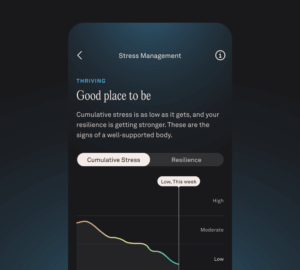Feeling like your nervous system is fried? You’re not alone. In our hyper-connected culture, constant notifications and the 24/7 news cycle can leave you feeling overwhelmed, overactivated, or stuck in a cycle of overthinking—all of which puts your “fight-or-flight” response in overdrive.
You likely already know about tried-and-true stress reduction techniques, such as breathwork, movement, and high-quality sleep. These strategies can certainly help. But there’s a lesser-known way to regulate your nervous system: stimulating the vagus nerve.
Extending from your brain to your gut, the vagus nerve is the longest cranial nerve and acts as the central control for your nervous system, explains Dr. Sara Szal, MD, Oura medical advisor and board-certified integrative medicine physician. It transmits vital signals that govern various functions such as your stress response and digestion. And strengthening it can help you tap into your body’s innate calming capabilities.
Below, discover 10 effective strategies to boost your “vagal tone” and feel calmer and more balanced—no matter how many notifications and news alerts come your way.
The Vagus Nerve: Your Path to a Calmer Nervous System
The autonomic nervous system (ANS) acts as your body’s behind-the-scenes conductor that controls involuntary functions like breathing, heart rate, and digestion.
The ANS has two main branches: The sympathetic nervous system (or “fight-or-flight” response) is the accelerator, throwing you into overdrive when faced with a stressor. On the other hand, the parasympathetic nervous system (or “rest-and-digest” response) acts as a brake, helping you feel more calm, cool, and collected.
The vagus nerve acts as the chief regulator of your parasympathetic nervous system. “Vagus actually translates to wanderer, and that’s exactly what it does,” Szal says. “It wanders through your body, relaying signals that slow your heart rate, boost digestion, reduce inflammation, and even influence mood by affecting neurotransmitters like serotonin.”
Essentially, it’s responsible for coordinating a calm and restorative state across your entire body.
What Is Vagal Tone?
Vagal tone measures the responsiveness of the vagus nerve, indicating the strength and speed of its calming signals.
High vagal tone allows your parasympathetic system to quickly lower stress and restore equilibrium. Conversely, low vagal tone leads to a slower response from rest-and-digest signals, leaving you in an activated state.
What does low vagal tone feel like?
When your vagus nerve isn’t sending calming signals, your body can remain stuck in a state of high alert. This low vagal tone is linked to a variety of mind and body issues as your «fight-or-flight» system stays dominant.
Be aware of these common symptoms, which indicate your nervous system might be struggling to find balance:
- Chronic stress and anxiety symptoms (persistent worry, feeling overwhelmed)
- Heightened reactivity (mood swings, irritability) and difficulty regulating emotions
- Fatigue and low energy despite adequate rest
- Insomnia or restless sleep
- Difficulty relaxing or “winding down”
- Digestive problems (bloating, constipation, poor nutrient absorption)
- Frequent illness
| Member Tip: Low vagal tone may be evident in your Oura data. For instance, HRV may be used as an index of vagal tone—when it’s low, it might be a sign that your nervous system is under strain. You may also notice a higher-than-average resting heart rate (RHR), a dip in Resilience, or higher Daytime Stress levels. |
What does high vagal tone feel like?
On the other hand, high vagal tone signifies a responsive and efficient vagus nerve. This means your body can quickly and effectively shift from stress to calm, allowing for better recovery and overall well-being. When your nervous system is balanced, you’ll likely experience:
- Resilience to stress: You can face challenges without feeling constantly overwhelmed, bouncing back more quickly from stressful situations.
- Emotional balance: You’re better able to manage your emotions, responding thoughtfully rather than reactively, with fewer mood swings.
- Improved sleep quality: A well-regulated nervous system allows for deeper, more restorative sleep.
- Enhanced social connection: A calm and regulated state fosters empathy and openness, making it easier to connect meaningfully with others and build strong relationships.
- Efficient digestion: Your «rest-and-digest» system can properly manage digestive processes, leading to better nutrient absorption and fewer gut issues
- Stronger immune function: By reducing chronic stress, a balanced nervous system supports a more robust immune system, making you less prone to illness.
READ MORE: 9 Tips to Strengthen Your Immune System
10 Strategies to Improve Vagal Tone and Regulate Your Nervous System
Chronic, unregulated stress and not enough recovery (read: sleep!) are the main culprits of low vagal tone. Armed with some simple practices, you can strengthen your vagal tone and feel calmer and more regulated overall.
1. Find stillness in yoga or meditation.
Yoga and meditation sharpen your mind–body connection and encourage slow, deep breathing, directly activating your parasympathetic system. Practices like loving-kindness meditation have been shown to be particularly effective at activating parasympathetic activity.
Try it: Find guided meditations in the Oura App under Explore content, or simply enjoy a moment of silence while listening to your breath. A yoga class can provide gentle movement as you focus on your inhales and exhales.
| Member Tip: Open, a leading mindfulness platform offering breathwork, meditation, movement, and sound. The Open app now integrates with Oura, giving members a personalized protocol to build their recovery ritual. |
2. Connect with others.

Ever notice how a good chat with a friend can instantly make you feel better? It’s no coincidence; connecting with others is a powerful way to regulate your nervous system. Positive social interactions—like sharing a laugh, having a deep conversation, or even just making genuine eye contact—trigger your parasympathetic «rest-and-digest» response and release bonding neurochemicals like oxytocin.
Similarly, physical touch is a potent vagus nerve stimulator. Hugs, gentle back rubs, or even petting your dog activate touch receptors that send soothing signals up the vagus nerve. This helps lower heart rate, reduce cortisol, and release more oxytocin, all contributing to a calmer nervous system and boosted vagal tone.
Try it: Call a friend or family member and check in. Alternatively, volunteer at a local charity or offer to help a stranger—giving back provides benefits to both the giver and receiver.
| Member Tip: Join a Circle with your friends and family members who also use Oura. You’ll be able to see each other’s high-level Oura data, providing a great conversation starter. |
3. Take a cold shower.
Cold showers act as a hormetic stressor: the initial chill kicks your sympathetic “alert” response into gear, then your body rebounds with a surge of parasympathetic activity—stimulating the vagus nerve and releasing mood-boosting neurochemicals.
Try it: Switch your shower to cold and stay under the stream as long as you can tolerate. If that’s too intense, alternate between hot and cold for 30–60-second intervals. Ready for more? Level up with a brief ice-bath plunge for a deeper vagal-tone workout.
READ MORE: Chill Out: 8 Science-Backed Benefits of Cold Exposure Therapy
4. Sing, hum, or chant.

The “Om” chanting that you do in Kundalini yoga isn’t just a quirk of the practice—it’s backed by science. A 2011 study found that the vibrating sensation that occurs when you chant “Om” causes a reduction in the brain’s limbic system (part of the fight-and-flight response) and stimulates the vagus nerve.
Try it: If chanting isn’t your thing, try singing, humming, or even gargling in the shower next time. It activates your vocal cords and the muscles in your throat, which are connected to the vagus nerve.
5. Laugh!
When you laugh, a few things happen: endorphins are released, cortisol is suppressed, you take in more oxygen, and your vocal cords are activated. The result? Your vagus nerve is stimulated, and stress diminishes. You don’t even have to laugh out loud; just hearing laughter increases parasympathetic activity.
Try it: Watch a funny TV show, or for extra points—meet up with a funny friend. The social connection plus laughing is the best vagus nerve stimulator around.
6. Roll on two massage balls.
Using tools like massage balls or a foam roller is a form on self-myofascial release, which targets the connective tissue (fascia) around your diaphragm and mid-back. “I like to place massage balls under my mid-back,” Szal says. “Rolling on them releases tension in your diaphragm and increases the capacity of your breath volume. This oxygenates the blood and connective tissues and stimulates the vagus nerve. It’s one of the best ways to relax your nervous system.”
Try it: Place two massage balls under your mid-back, with one on each side of the spine. Lay back, moving the balls a couple of inches toward the midback. Then, shift your hips to move the balls around.
7. Practice deep breathing.
Slow, deep diaphragmatic breaths engage stretch receptors in your lungs, which send signals via the vagus nerve to your brainstem—slowing your heart rate, boosting parasympathetic output, and dialing back the “fight-or-flight” response.
A simple physiological sigh (a double inhale followed by a long, controlled exhale) amplifies this effect by fully inflating and then emptying your lungs, triggering baroreceptor feedback that further calms your system.
Try it: Inhale deeply, then, without breathing out, inhale again. Exhale completely. Repeat this for five minutes.
| Member Story: As Oura member Dr. Kaushik Ram practiced vagal breathing, he saw his HRV increase on Oura, helping him feel more calm and centered. |
8. Book an acupuncture session.
Acupuncture inserts thin needles into specific points on the body, then applies gentle manual or electrical stimulation. This activates sensory nerves that connect directly to your autonomic system—enhancing parasympathetic tone, reducing sympathetic overdrive, and triggering anti-inflammatory pathways.
In other words, acupuncture can help regulate your nervous system and calm chronic inflammation.
Try it: Book an acupuncture session near you and let your practitioner know you want to focus on vagal nerve stimulation so they can focus on the right acupuncture points.
9. Eat slowly.

When you eat at a relaxed pace and chew thoroughly, stretch receptors in your stomach send clear signals up the vagus nerve to your brain—helping you digest more efficiently, feel satisfied sooner, and stay calm rather than rushing into a stress response.
Try it: Put away any distractions next time you eat. Try to be present, and eat slowly.
| Member Tip: Let Oura Meals feature unpack how well your choices are fueling you, so you can beat cravings and energy slumps, identify nutritional imbalances, and stay on track toward your goals. |
10. Consider a fast.
Intermittent fasting (for 16–24 hours) has been shown in research to shift autonomic balance toward parasympathetic dominance, measured by increased HRV and lowered heart rate.
When you go without food for a period of time, it dampens sympathetic signaling and your gut sends calming feedback up to your brain, triggering stronger “rest-and-digest” messages back down through your vagus nerve.
Try it: Always speak to a medical provider before attempting a fast. You can start with a 16:8 fast, which involves fasting for 16 hours overnight and typically into the morning and then eating in an 8-hour window.











